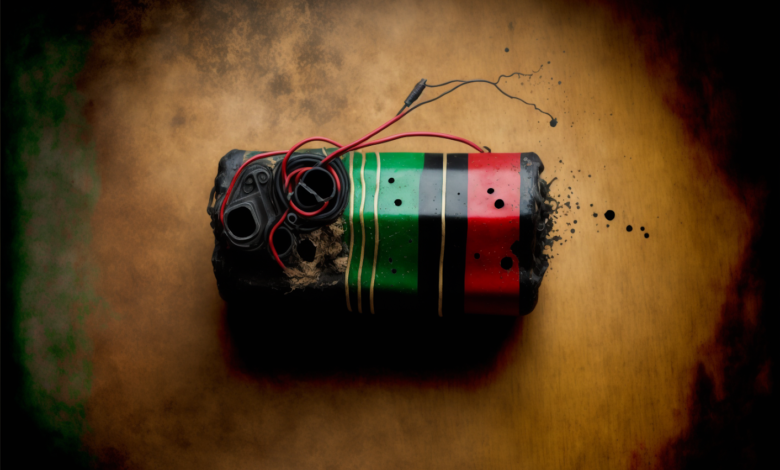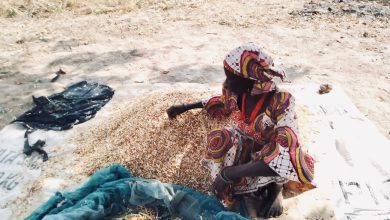Separatist Militants In Nigeria Are Increasingly Using Explosives
Separatists in the volatile southeast region use homemade bombs as part of their violent campaign against state forces, a trend that could have a long-term impact on public safety and the environment.

Separatist militants in southeastern Nigeria are increasingly adopting explosive devices and crude launch systems to target security forces and government facilities.
The intensity and frequency of attacks by the proscribed Indigenous People of Biafra (IPOB) have rapidly deteriorated since it formed an armed wing known as the Eastern Security Network (ESN) in Dec. 2020.
Raids by security forces have led to the destruction of camps and the recovery of lethal weapons, including homemade bombs and grenades. These discoveries highlight the militant group’s considerable skill in handling, processing, and deploying explosives.
Although that capacity is still limited, a failure to disrupt the threat could create a bigger security risk.
Recovery of explosive materials and devices
“I was very scared when I started hearing of the heavy shootings and bomb explosions,” a local, Uju Okafor, said after a Divisional Police facility in the Ihiala area of Anambra was attacked with Improvised Explosive Devices (IED) and gunfire in Dec. 2022.
During the same period, the police in neighbouring Imo state arrested an Army deserter serving as a commander in the group. Searching his house led to the recovery of several weapons, including nine locally made hand-grenades, five pump action guns, two double barrel guns, and four locally-made pistols.
The deserter led security forces to a camp, where they reportedly discovered “five GPMG guns, four cut-to-size double-barrelled guns, five pump-action guns, three locally-made bombs, 19 rounds of AK-47 live ammunition, 52 live cartridges, 14 tear gas canisters, two police handcuffs, four desert boots, among others”.
In Ebonyi state, the Police recovered IEDs from what was described as a major IPOB bomb factory in the Southeast. “What we have here today is a complete bomb factory, the biggest so far recovered in the whole of the Southeast. In fact, these IEDs are capable of destroying a very large building and doing a whole lot of massive killing of any living thing around the area, ” the police told journalists.
A joint military and law enforcement operation in December also resulted in the raiding of a camp in Ebonyi. As a result, the security forces retrieved several items, including 12 No. 36 grenades (Mills bombs), two pump action shotguns, fabricated guns, detonators, and several rounds of ammunition.
The Army’s 34 Brigade, in May, captured a stockpile of arms and ammunition alongside an IED after an encounter with the separatist militants in Imo.
Earlier in April, the Police in Imo disclosed the arrest of an IPOB operative manufacturing bombs used to target police and government facilities. The operation resulted in the recovery of IEDs, cannon steel pipe, potassium nitrate, sulphur, and gunpowder.

The deployment of explosive devices
The employment of these explosives has contributed to the campaign of violence and attacks in the region. For example, the country’s Independent National Electoral Commission (INEC) in Imo was attacked with gunfire and explosives in December.
A subsequent police counterattack led to the seizure of “three AK-47 rifles, four pump action guns, three improvised explosive devices, and four locally made bombs”.
In August, soldiers encountered separatist militants using homemade launchers for the deployment of explosive projectiles. The Army, in a statement, said the location, Eke Ututu market, had recently become an ambush flashpoint as dissidents use explosives and firearms to target troops on routine patrol. The Explosive Ordnance Disposal (EOD) team afterwards recovered several IEDs planted along the road and the crude launchers.
In June, separatist militants enforcing a sit-at-home detonated an explosive device in a local market in the Oguta Local Government Area of Imo. A witness recalled they “threw a local bomb inside the market, and everybody started running for safety. They (also) poured fuel on two vehicles and everywhere went up in flames”.
Similarly, in June, two IPOB members attempting to evade security forces were injured along Eke Ututu–Orsu road after stepping on a buried IED. “The outlawed group have severally planted IEDs along troops’ patrol routes in [a] failed effort to bring harm to the troops,” the Army said.
In March, a police facility located in the Owerri West area of Imo was barricaded and targeted with small arms and explosive devices.
Last year, the law enforcement agency seized what appeared to be an artisanal grenade-type explosive device and projectile designed in the pattern of a rocket-propelled grenade (RPG) in Anambra state.

“The command recovered a locally fabricated RPG bomb and a hand grenade at the scene of the shootout between gunmen suspected to be ESN militants and the joint security convoy led by the commissioner himself,” the police said in a statement.
The use of these bombs does not only pose a threat to security forces but could endanger civilians, especially commuters and farmers. It would also aggravate the existing threat from unexploded ordnance left from the bloody Biafran civil war between 1967 and 1970.
The government, in 2010, carried out a survey of the affected areas and discovered that several bombs, including conventional and artisanal landmines, were still posing serious danger. In 2012, three unexploded bombs were discovered at a construction site in Enugu by workers digging a foundation.
Following the recovery, the field administrator of the Nigerian Mine Action Centre, a department of the Federal Ministry of Defence, Emeka Uhegbu, told journalists that over 50,000 unused explosives were scattered across 12 states of the Southeast, South-south and North-central regions.
In 2017, authorities agreed to pay victims of the war ₦88 billion. It included ₦38 billion “for the evacuation of abandoned bombs and other lethal weapons and construction of schools, courts, churches and mosques among others in the affected areas”.
They revealed that 17,000 bombs were recovered in war-ravaged communities and destroyed by a de-mining company, while about 1,317 bombs were stored at the Mine Action Centre in Owerri.
HumAngle has also previously documented the profile of arms used by IPOB militants, which “appears to consist mainly of firearms from transnational origins, local fabricators, and those stolen from security forces”. Notable was the significant presence of smuggled pump action shotguns and assault rifles stolen from security forces, particularly the police.
Support Our Journalism
There are millions of ordinary people affected by conflict in Africa whose stories are missing in the mainstream media. HumAngle is determined to tell those challenging and under-reported stories, hoping that the people impacted by these conflicts will find the safety and security they deserve.
To ensure that we continue to provide public service coverage, we have a small favour to ask you. We want you to be part of our journalistic endeavour by contributing a token to us.
Your donation will further promote a robust, free, and independent media.
Donate HereStay Closer To The Stories That Matter




